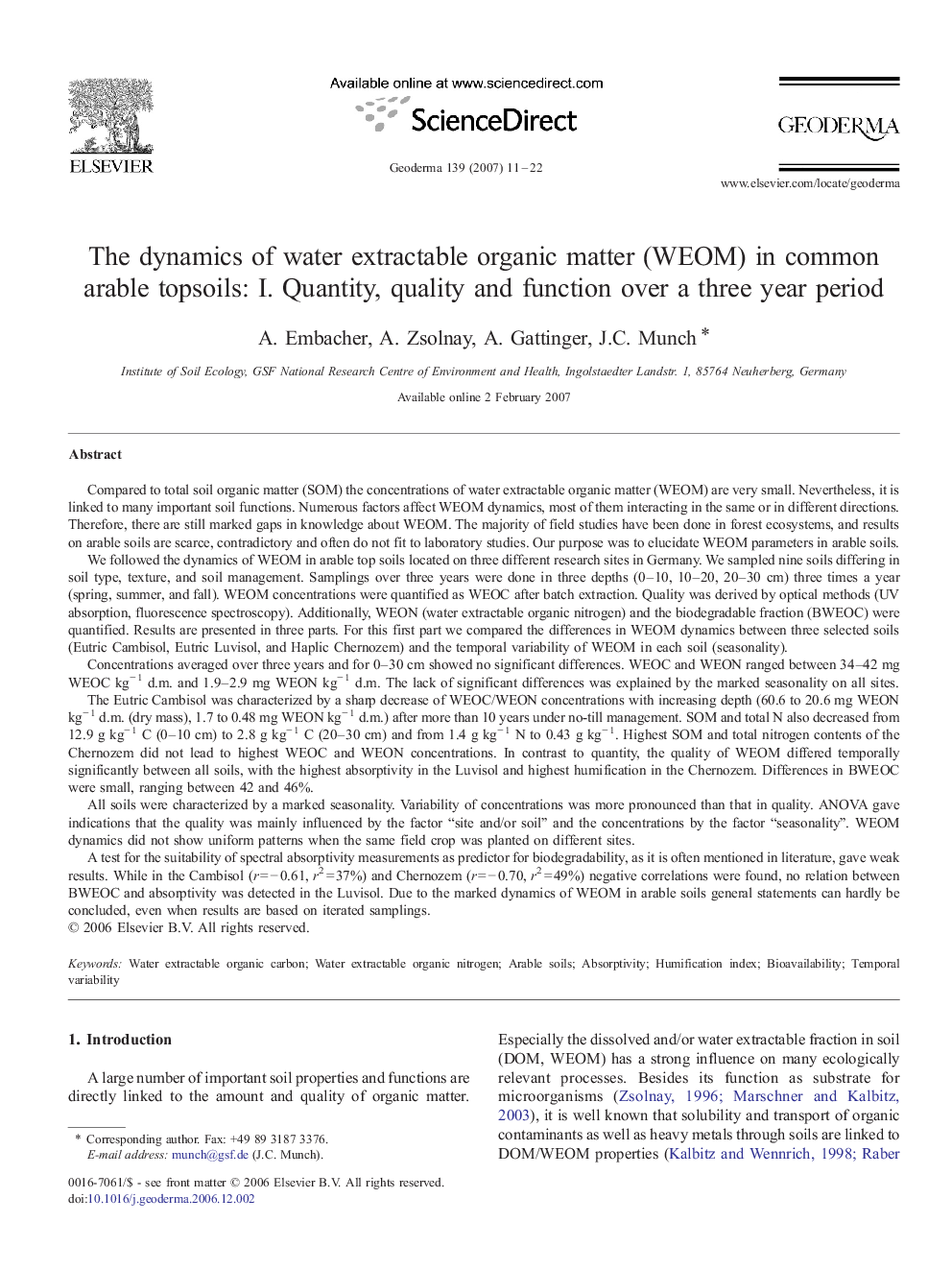| کد مقاله | کد نشریه | سال انتشار | مقاله انگلیسی | نسخه تمام متن |
|---|---|---|---|---|
| 4575472 | 1629555 | 2007 | 12 صفحه PDF | دانلود رایگان |

Compared to total soil organic matter (SOM) the concentrations of water extractable organic matter (WEOM) are very small. Nevertheless, it is linked to many important soil functions. Numerous factors affect WEOM dynamics, most of them interacting in the same or in different directions. Therefore, there are still marked gaps in knowledge about WEOM. The majority of field studies have been done in forest ecosystems, and results on arable soils are scarce, contradictory and often do not fit to laboratory studies. Our purpose was to elucidate WEOM parameters in arable soils.We followed the dynamics of WEOM in arable top soils located on three different research sites in Germany. We sampled nine soils differing in soil type, texture, and soil management. Samplings over three years were done in three depths (0–10, 10–20, 20–30 cm) three times a year (spring, summer, and fall). WEOM concentrations were quantified as WEOC after batch extraction. Quality was derived by optical methods (UV absorption, fluorescence spectroscopy). Additionally, WEON (water extractable organic nitrogen) and the biodegradable fraction (BWEOC) were quantified. Results are presented in three parts. For this first part we compared the differences in WEOM dynamics between three selected soils (Eutric Cambisol, Eutric Luvisol, and Haplic Chernozem) and the temporal variability of WEOM in each soil (seasonality).Concentrations averaged over three years and for 0–30 cm showed no significant differences. WEOC and WEON ranged between 34–42 mg WEOC kg− 1 d.m. and 1.9–2.9 mg WEON kg− 1 d.m. The lack of significant differences was explained by the marked seasonality on all sites.The Eutric Cambisol was characterized by a sharp decrease of WEOC/WEON concentrations with increasing depth (60.6 to 20.6 mg WEON kg− 1 d.m. (dry mass), 1.7 to 0.48 mg WEON kg− 1 d.m.) after more than 10 years under no-till management. SOM and total N also decreased from 12.9 g kg− 1 C (0–10 cm) to 2.8 g kg− 1 C (20–30 cm) and from 1.4 g kg− 1 N to 0.43 g kg− 1. Highest SOM and total nitrogen contents of the Chernozem did not lead to highest WEOC and WEON concentrations. In contrast to quantity, the quality of WEOM differed temporally significantly between all soils, with the highest absorptivity in the Luvisol and highest humification in the Chernozem. Differences in BWEOC were small, ranging between 42 and 46%.All soils were characterized by a marked seasonality. Variability of concentrations was more pronounced than that in quality. ANOVA gave indications that the quality was mainly influenced by the factor “site and/or soil” and the concentrations by the factor “seasonality”. WEOM dynamics did not show uniform patterns when the same field crop was planted on different sites.A test for the suitability of spectral absorptivity measurements as predictor for biodegradability, as it is often mentioned in literature, gave weak results. While in the Cambisol (r = − 0.61, r2 = 37%) and Chernozem (r = − 0.70, r2 = 49%) negative correlations were found, no relation between BWEOC and absorptivity was detected in the Luvisol. Due to the marked dynamics of WEOM in arable soils general statements can hardly be concluded, even when results are based on iterated samplings.
Journal: Geoderma - Volume 139, Issues 1–2, 15 April 2007, Pages 11–22